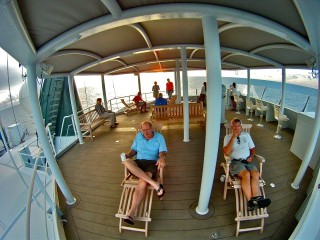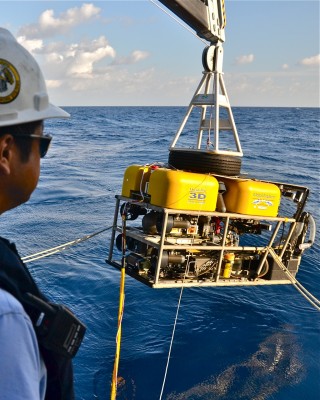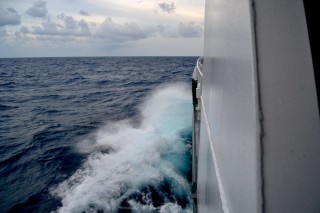“Do you like it?” Asked Toshi Mikagawa, one of the ROV engineers from Deep Sea Systems International, and indeed I did.

I was looking at the 3D feed from the company’s Ocean Explorer ROV. Just as it was designed to do, the 3D video gave the feeling that I was actually moving past the corals and fishes on the screen. “This project nearly killed me,” Mikagawa told me, “I worked on this for two years.” There are far more challenges beyond standard focus with 3D, including how you control camera angles, but it was well worth the effort.
Sadly, feeling like “you’re there” wasn’t an especially special sensation today at Mysterious Bank. If the place held any mysteries they’ll remain locked away. “What a mess,” is how chief scientist Tom Shirley, from Texas A&M University Corpus Christi, summed it up. “I like the name, but not much else.” Though the dive started off with a promising pass by a shark, that was nearly the end of the excitement.
“I like the name, but not much else.” –Tom Shirley, on the wonders of Mysterious Bank

For some reason this bank was covered by extremely turbid, or murky, water—sometimes referred to as the nepheloid layer. Nearly blinded by the silt, the team moved to the highest ground the silly bump had to offer, but we still couldn’t find clear water. That’s when Shirley made the call that we’d bail. One consolation prize was that an intriguing fish called a lookdown, a shiny silver species with a blunt face, became rather enamored of our camera on the way up, offering some great views. And then, just before the ROV surfaced, a dolphin made several passes.
Moving On

We just moved on, and by 1:00 p.m. the ROV was on its way to the bottom again at a spot called Blackfish Ridge. Here the 3D, something with which only a handful of ROVs around the world are equipped, proved much more useful. While 3D is more of a novelty or nicety with a movie, in the water it serves a very specific purpose. One of the great challenges for ROV pilots is the lack of depth perception with 2D video. That makes the already difficult task of manipulating a robotic arm to pick something up all the more daunting. But 3D can solve that problem. Here the engineers used it to aid collection of a variety of samples including rocks, corals, and, by accident, a small shark’s tooth.
After dives we can also watch the collected video in 3D—and that has proven a huge help to the team I described yesterday that’s doing fish counts. In 2D a group of fish is hard to differentiate, but depth perception makes it much easier to tell each of them apart—even if though it meant having to wear those strange glasses for hours on end as waves smacked the ship.
Lots of Little Fellers

At Blackfish Ridge we found yet another unique world distinct from past dives. There were no large schools of snapper here, but we saw lots of large amberjacks. And there were memorable scenes like a ring of colorful sponges surrounded by hundreds of damselfishes of varying species. “I’ve been amazed by the density of juvenile fish out here,” says Wes Tunnell, from Texas A&M’s Harte Research Institute, “that surprises me.”
So, though we weren’t off to such a great start, the day proved valuable. Seas are not returning to their former placid mode, but should be calm enough for the rest of the expedition. Tomorrow, it’s on to a bank previously marked on maps only as an “obstruction.” It’ll be our deepest and final dive.
Dolphin encounter filmed by the Deep Sea Sysems International Global Explorer MK3 ROV operated from the Schmidt Ocean Institute research vessel Falkor in the Gulf of Mexico off the coast of Corpus Christi on September 26, 2012. Video credit: Nathan Cunningham, marine technician aboard R/V Falkor

